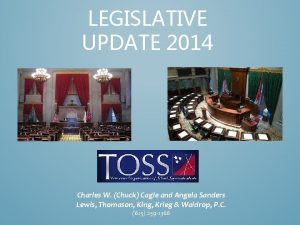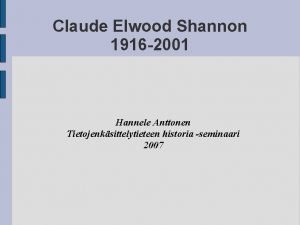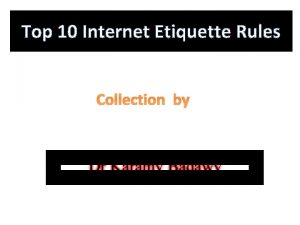Digital Literacy and Etiquette Lesson Hannah Cagle ONL507






- Slides: 6

Digital Literacy and Etiquette Lesson Hannah Cagle ONL/507 8/5/19 Professor Jackie Mangieri Brown

The Lesson: Background Standards Addressed: VA SOL LS. 10 c and LS. 11 d, e (Virginia Department of Education, 2019). Focus Question: How does the concept of global warming impact wildlife in the Chesapeake Bay? Related Questions: What environmental factors cause habitat destruction to occur? How does sea level rise affect organisms that live in the Chesapeake Bay? What are the causes for rising average temperatures? What species are the most impacted by global warming? Objectives: 1. Students will research three causes of global warming and their impacts on the Chesapeake Bay. 2. Students will research one key species living in the Chesapeake Bay and create a blog describing three impacts global warming has on that key species.

Resources Teacher’s laptop/computer Projector or Smart. Board (to show teacher-made blog on the screen) Laptops or Computers (one person if done individually, one per group if done in pairs)

Activity Description: Create a Word. Press for the class. Make a generic username and password that all students can have access to. 1. Show students a blog that you have made via Word. Press (or you may show this one). Have a brief discussion (approx 5 -10 minutes) about the tone, presentation, and professionalism of the blog. 2. Show students the criteria for their Word. Press Blog: a) Students must research three causes of global warming from credible sources. b) Students must then research a species in the Chesapeake Bay that is impacted by global warming. c) Students must include how the three causes of global warming impact their species in their blog post. 3. Have students make a draft of their post in Google Documents and have them share their document with you. From there, you can make edits and add comments to make sure that their post is factual and appropriate for your class run blog. 4. Once you have proof-read their blog post, publish to the blog site for others to see!

Extension Send the website link to your colleagues. Have them comment and provide suggestions to the blog posts in order to improve Digital Citizenship.

Teaching Tips 1. 2. 3. 4. Expose students early on to technology in the classroom: Start in the beginning of the school year with your district’s Acceptable Use Policy. Just like a science lab would go over lab safety, going over your district’s AUP can help students understand the correct way to carry themselves in a school environment. Create a quick engaging lesson: Not enough time to spend 45 minutes outside of your curriculum? Need a good hook for your class? Have 5 extra minutes to spare in class? Create a lesson you can use during these crunch times. Show examples of appropriate and inappropriate behaviors on the web. Have students identify the behaviors they should model. Discuss why the inappropriate behaviors are not tolerated. Google yourself: Have students come up either one by one or complete whole group. Google a person in the classroom and Google someone famous. Discuss what is appropriate to have online and what is inappropriate. Utilize social media: Use social media often in the classroom. Create a class wide social media page that everyone can view (ex: Twitter). Make it related to your class subject. Post ONLY about the content of your curriculum and encourage students to interact with you about that topic. Use this as a hook or as a formative assessment to understand student knowledge.











